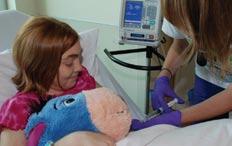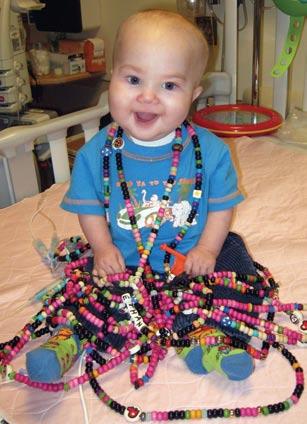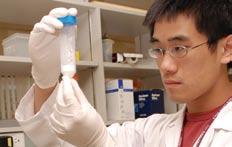
7 minute read
at camp Julia’s dancing leg

at the hospital
Ethan’s beaded journey
Imagine a string of beads. 2,561 beads. Pink, blue, black and red— piled high on your kitchen table. Now stretch them out. 68.5 feet of colour running the perimeter of your kitchen—five times.
Consider that each bead represents a medical procedure. Now consider that this length of beads represents the short life of a 14month-old child—Ethan Olmats.
Ethan was diagnosed with infant acute lymphoblastic leukemia at three months. There wasn’t a day in his life when he wasn’t sick. Ethan passed away in July 2007, after sharing a big smile with his uncle Paul, who travelled to meet him for the first time.
The beaded journey program, funded by KCCFA, is designed to help children understand what’s happening to their bodies by giving them a way to record their experience. Each bead represents a treatment or milestone on the journey.
And when a child is too young to make the beaded journey himself, his family can help record the journey for him. Ethan’s beaded journey is exceptionally long because he was very sick and his family lovingly recorded each and every step. It’s also long because he had a lot of visitors. Many of the beads represent happy times—a trip to Bowness Park, visits from his big brothers and Ethan’s first birthday.
“All the pink ones,” says his older brother Kevin, “are Ethan’s visitors.”
“And the large pink one with the red polka dots is a special one,” says Ethan’s mother Colleen.“That’s the first time his big brothers visited him in intensive care at the hospital.”
The bead Colleen points to appears early in Ethan’s beaded journey because Erik and Colleen Olmats made a point of including the older boys in the journey. They also juggled work schedules and extracurricular activities to ensure that life for three-year-old Cameron and seven-year-old Kevin remained relatively normal.
It’s an approach they adopted early and maintain today—even in their grief. The Olmats are a loving family that openly talks about Ethan and the loss of his joyful presence.
The beads help the Olmats regain perspective: “When I’m feeling down,” says Erik, “I just look at these beads and see what Ethan went through and I know I have nothing to feel badly about.”
The beads also help the older boys to understand. When Ethan was on treatment, Kevin brought the beads to school to show his classmates to explain what his baby brother was going through. And when their youngest son Cameron gets older, Colleen says, “the beads are there to help him understand too.”
The beaded journey
KCCFA funds the beaded journey program at the Alberta Children’s Hospital. Each bead represents a milestone in the trek against cancer, giving kids a chance to understand and express their experience. The program is one of KCCFA’s many Clinical Support initiatives that help families at the hospital.

Photo courtesy of Erik and Colleen Olmats.
—Tim Cahill
Opposite left: Child life specialist Carolyn Daly with Ethan’s older brother Kevin and his father Erik Olmats at the Alberta Children’s Hospital. The Olmats lived at the hospital 24/7 during the final hours of Ethan’s life.
Opposite right: Aurora gets her shot at the outpatient clinic at the Alberta Children’s Hospital.
Left: Ethan with his beaded journey at the hospital. Each bead in the long stretch of colour represents a treatment or milestone in his cancer journey. Although Ethan never knew a day without sickness, he somehow always managed to cheer his visitors with a smile.
Ethan’s beaded journey
NEED Bead Procedure/event
Red glass Turquoise Black Blue Cream Glow-in-the-dark Gold
diagnosis clinic visit pokes (needles, blood tests) hospital admission chemotherapy visits from brothers miscellaneous medical Green dressing change Silver metal with a serpent Broviac placement Pink visits from loved ones Red blood transfusion Yellow tests and scans Rainbow round special events Purple lumbar puncture or bone marrow test Large blue with white polka dots milestones (rolling over, sitting up, waving, first words, crawling)
In 2007/08, KCCFA invested $288,686 to help the many nurses, doctors, chaplains, social workers and the music therapist at the hospital give Alberta families the best possible care on their cancer journey.
“To get through the hardest journey we need take only one step at a time, but we must keep on stepping.” —Chinese Proverb

Above: University of Calgary student Eric Tsu received a KCCFA summer student research scholarship to work with Dr. Aru Narendran, screening cell lines in acute lymphocytic leukemia to test their response to different treatments.
Opposite right: Dr. Aru Narendran’s research, funded by KCCFA, is showing promise for a cure for AT/RT, a rare and aggressive brain tumour that appears in infants.
in the lab
The little cell that could
The smallest of life forms made it big this spring, when the Journal of Neuro-Oncology published the research findings of Dr. Aru Narendran on atypical teratoid/ rhabdoid tumour (AT/RT), a rare and aggressive brain cancer that grows in infants and small children.
Affectionately dubbed KCCF1 after the study’s benefactor, this tiny life form is the little cell that could. It’s managed, against great odds, to grow and survive in a petri dish in a Calgary laboratory.
Most cancer cells will not survive outside the human body, so growing AT/RT in a petri dish is an important step. Because AT/RT is so rare and the cells often die in a laboratory setting, there is only a handful of cell lines currently available for research.
What’s exciting about Narendran’s research is the method. He and his team initiated the growth of the cancer cells by adding small amounts of brain fluid, the same fluid in which these cells normally grow, to the culture medium. Scientists believe this unique approach determined his success in growing KCCF1.
The method is already reaping rewards: “We’ve been able to study this cancer cell line,” says Dr. Narendran, “and we have managed to pinpoint a potential molecular pathway it uses to grow.” It appears that the cancer cells are excessively stimulated to grow by a natural hormone found in the body.
Armed with this new information, the research team tested a new drug to inhibit the activity of this hormone. As expected, even small amounts of the drug stopped the growth of the tumour cells. “It’s still very preliminary,” Narendran says, “we need to do a lot more work to understand how this drug might be used effectively and safely in children, but it looks promising.” now travelled to other laboratories, where scientists are using it to investigate new therapeutic approaches to cure children with AT/RT. By unlocking the secrets of this aggressive brain cancer, the little cell that could may very well be the little cell that cures.
New hope
The last 50 years have seen an explosion in cancer research and understanding. Each discovery counts and over time leads to decisive breakthroughs. In Canada, research advances have seen survival rates for children rise to about 80 per cent in our lifetime.
While survival rates have improved, some cancers continue to elude medical science. With your support, scientists will continue the quest to find a cure for all cancers—and all children.
1890s Radiation
• X-ray discovered (radiation is still used to diagnose and treat cancer today)
1940s Chemotherapy
• Investigation of chemical warfare agents for therapeutic reasons initiates a frenzy in cancer drug studies • First drug to induce long-term remissions in ALL* patients
1950s DNA breakthrough
• DNA structure is decoded, initiating a breakthrough in cel- lular biology, which leads to insights into the genetic nature of cancer
Anti-cancer drugs
• New drugs found to 1) inhibit cell division 2) treat leukemia 3) treat solid tumours
1960s to present Combination therapy
• Combination therapy (several drugs given at once) circumvents the tendency of cancer cells to resist single-drug therapies • Combination therapy becomes the baseline for all cancer drug regimes, making ALL* and Hodgkin’s disease largely curable
Adjuvant therapy
• Adjuvant therapy (reducing the tumour by surgery followed by chemotherapy to kill remaining cancer cells) developed
Supportive care
• New drugs reduce the side effects of cancer drugs • New drugs support patient immune systems, reduce nausea, pain and anxiety during treat- ment
Targeted therapy
• Advances in cellular biology and genetics reveal the genetic nature of cancer • New drugs targeted to inhibit cancer cell growth without damaging healthy cells lead to more effective therapies with fewer side effects

History of cancer research
Survival rates
Percentage of children surviving five years after diagnosis
100
90
80
70
60
50
40
Year of diagnosis




